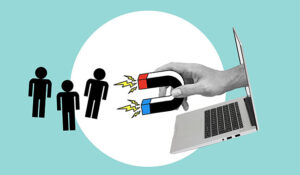Have you ever wondered how many customers come back and use your services or buy your products? This metric is called customer retention rate, and it helps businesses satisfy their customers and grow.
Measuring customer retention is necessary for brands in competitive markets. If you want to know how to calculate customer retention rate or what is the customer retention rate formula for your business, read this article carefully.
How to Calculate Customer Retention Rate
The retention rate is the percentage of customers every company keeps over time. It is one of the most important metrics to measure a business’s success.
If measuring customer retention leads to a high percentage, it shows a low turnover rate for a company.
Customer retention rates also allow businesses to track the progress of their objectives and initiatives over time.
The retention rate of more than 85 percent is satisfactory for most businesses, while 90 percent is considered the best and healthiest rate.
Assessing customers’ interest shows how effective brand planning is and how well new products and service improvements are at maintaining old customers.
If you want to calculate the customer retention rate for your company, divide the number of active customers or users who renew their subscriptions at the given time by the total number of active users at the beginning.
The customer retention rate formula is straightforward. For example, the number of active users who continue to subscribe divided by the total active users at the beginning of a period equals the retention rate.
How to Calculate Customer Retention Rate in Other Ways?
There are many ways to calculate customer retention rates in companies, of which we described the most common one above.
The following are other ways to measure customer retention that you may find more suitable for your situation.
Calculate Customer Retention Rate by Cohort Analysis
Behavioral analytics is used in cohort analysis to track customer behavior and interaction over time. For example, it separates customers into different segments or cohorts to assess their behavior individually.
Cohort analysis can study customer lifetime and how well a new product or service has brought them back to the brand using comparative periods.
Product quality, a positive customer experience, and the diversity of options available can all contribute to reasonable retention rates over time.
Customer Retention Rate Formula
There is a simple way to learn how the customers feel about the brand or company and what type of impression the business has made on them.
This strategy entails asking customers a simple question: How likely do you suggest the brand to your friends on a scale of 1 to 10?
Detractors are those who react with a score of 1 to 6, while promoters are those who reply with a score of 7 or more.
You can even interview detractors and advocates separately to understand better why they had the given ratings.
Measuring Customer Retention by Repeat Purchase Rate
The repeat purchase rate estimates the number of customers that engage with a brand more than once.
This odd number denotes a previous positive experience that inspired the customer to engage with the business again.
For different sorts of businesses, repeat purchases might indicate different things. For example, depending on the nature of the business, the number of times the brand classifies them as repeat customers may vary.
The companies should comprehend the customer pain point that leads to their systematic strategy.
It helps develop loyal consumers and understand the brand’s advantages and disadvantages from their perspective.
How to Calculate Customer Retention Rate
Churn indicates how many customers a company has lost, which is the opposite of the retention rate.
It identifies customers who have departed or moved their preferences to other brands because of bad service or a better alternative supplied by a competitor.
The churn rate is derived by multiplying the total number of customers at the start of the period by 100 and dividing the number of customers lost over time by the total number of customers at the start.
The churn rate indicates the percentage of customers leaving the company, negatively influencing revenue.
Calculate Customer Retention Rate by Customer Lifetime Value
Customer lifetime value predicts how much a customer from a specific category spends on the brand’s offerings.
You may estimate how much to expect to make from a particular customer category.
It is an excellent technique to determine the primary target consumers, create targeted customer profiles, prioritize segments, and allocate resources based on expected returns.
Business owners and analyzers use this metric to evaluate and compare potential customers based on the amount of money they bring in.
10 Proven Ways to Increase Customer Retention Rate
The following tips are suitable for organizations looking to improve customer retention rates. They can form a solid foundation for a successful customer retention strategy when used together.
1. Improve the Onboarding Process
Customers do not grasp how to get the most out of a product, which is one of the leading causes of churn.
A business should ensure that the client knows the product’s significant features during onboarding.
Training sessions that teach users about the best methods and standardized workflows are great ways to do this.
Giving customers the proper tools to thrive can increase customer satisfaction and reduce churn in the long run.
2. Develop a Realistic Roadmap for the Customers
When it comes to creating and meeting client expectations, be realistic. Develop a meeting with new customers to plan a comfortable path for you.
You should include realistic milestones and attainable targets in the plan. The customer success team should view and act on the customer roadmap.
3. Use Customers’ Input
When it comes to customer retention, customer input is critical. The feeling of every customer regarding the brand influences the business’s success.
Companies must collect feedback from their customers. It can be done through customer satisfaction surveys, website feedback bars, or social media comments.
4. Consider Customer Experience
The customer experience mapping and customer journey mapping describe how they interact with the brand across all touchpoints.
The better companies understand the paths for purchasing, the better they can improve customers’ experience.
5. Use Social Media Strategically
Most customers want immediate and personalized service, and social media plays an important role here.
Social networking is an excellent tool to resolve potential customer service issues or questions.
It is also a fantastic approach to building a cohesive and integrated consumer experience.
6. Group Customers
How a company gathers data and then acts on it is critical to its success. Based on how they interact with the business, sales CRM software typically divides prospects and customers into groups.
Businesses can use these facts to personalize marketing campaigns to their customers’ and prospects’ particular levels of awareness.
When retargeting, email segmentation is the key to getting the appropriate information to the right people at the right time.
7. Send out Automatic Emails to Encourage Inactive Users
Keeping consumers and potential clients active as possible is a proven way to increase the customer retention rate for businesses.
If a user has not been active for a long time, an automated email or a message on social media sent through a CRM system can persuade them to act.
If you track how users engage with a product and discover that they have only used a tiny portion of the features, sending them an email describing how to use the remainder of the functions can pique their interest.
Educational content, such as complete guides or successful case studies from other clients, could be included in emails and messages.
Remember that sending many automated emails or messages to customers irritates them, especially those already familiar with the product.
8. Upsell to the Customers
Upselling loyal clients is a terrific method to increase customer retention. As a result, they get more invested in the brand when you persuade them that a premium or improved service is necessary.
Existing content assets, as if as eBooks and whitepapers, are another proven way to remind existing consumers about all of the things the product has to offer while also keeping them engaged.
9. Develop a Customer Loyalty Program
A customer loyalty program is a beautiful approach to giving back to customers while also allowing for the development of a personal relationship.
One compelling justification for using customer happiness as a KPI is that it makes recognizing customers more likely to churn easier.
Before a user churns, there is usually a slew of warning indicators, one of which is the degree of activity. For example, the company should investigate why a customer has not used the product in 30 days.
Some companies use a traffic light system. Users that are happy with the product and are unlikely to churn are shown in green.
Amber is allocated for users who may have an open issue that is not life-threatening. The color red is reserved for users at high risk of churning.
It could be due to a severe complaint filed against the company or just because they have expressed their dissatisfaction.
10. Consider a Referral Campaign
A referral program can encourage satisfied consumers to suggest to their friends and family and improve client loyalty.
You can significantly improve the number of new signups while engaging the existing customers by offering credits, upgrades, or other bonuses to existing clients.
Turning most devoted customers into brand ambassadors strengthens their emotional attachment to your company, increasing retention.
Customer retention is one of the most effective ways to drive sales and grow business. Although the customer retention rate formula is firm and stable, improving the rate can feel more like an art and takes a lot of experimentation.
Driving customer retention rate comes down to creating a positive customer experience and having strong communication with customers. So now it is your turn; how to calculate customer retention rate, and what is your customer retention rate?
This blog post has been re-published by kind permission of Scorebuddy – View the Original Article
For more information about Scorebuddy - visit the Scorebuddy Website
Call Centre Helper is not responsible for the content of these guest blog posts. The opinions expressed in this article are those of the author, and do not necessarily reflect those of Call Centre Helper.
Author: Scorebuddy
Published On: 4th Jul 2022
Read more about - Guest Blogs, Scorebuddy






 Scorebuddy is quality assurance solution for scoring customer service calls, emails and web chat. It is a dedicated, stand-alone staff scoring system based in the cloud, requiring no integration.
Scorebuddy is quality assurance solution for scoring customer service calls, emails and web chat. It is a dedicated, stand-alone staff scoring system based in the cloud, requiring no integration. 









